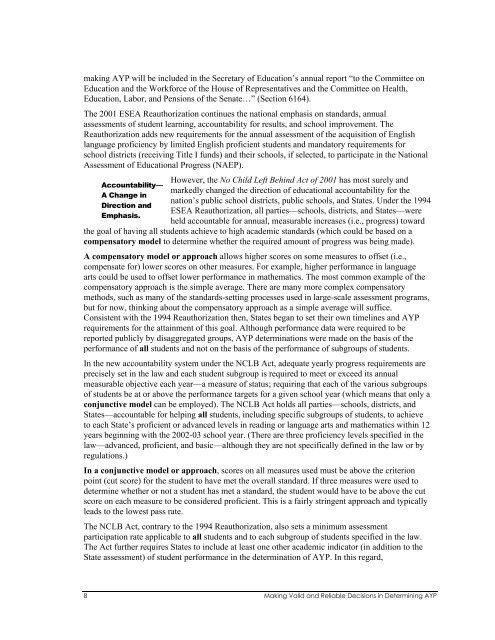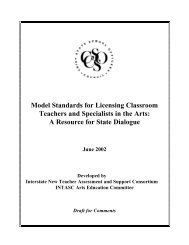making AYP will be included in the Secretary of Education’s annual report “to the Committee onEducation and the Workforce of the House of Representatives and the Committee on Health,Education, Labor, and Pensions of the Senate…” (Section 6164).The 2001 ESEA Reauthorization continues the national emphasis on standards, annualassessments of student learning, accountability for results, and school improvement. TheReauthorization adds new requirements for the annual assessment of the acquisition of Englishlanguage proficiency by limited English proficient students and mandatory requirements forschool districts (receiving Title I funds) and their schools, if selected, to participate in the NationalAssessment of Educational Progress (NAEP).Accountability—A Change inDirection andEmphasis.However, the No Child Left Behind Act of 2001 has most surely andmarkedly changed the direction of educational accountability for thenation’s public school districts, public schools, and States. Under the 1994ESEA Reauthorization, all parties—schools, districts, and States—wereheld accountable for annual, measurable increases (i.e., progress) towardthe goal of having all students achieve to high academic standards (which could be based on acompensatory model to determine whether the required amount of progress was being made).A compensatory model or approach allows higher scores on some measures to offset (i.e.,compensate for) lower scores on other measures. For example, higher performance in languagearts could be used to offset lower performance in mathematics. The most common example of thecompensatory approach is the simple average. There are many more complex compensatorymethods, such as many of the standards-setting processes used in large-scale assessment programs,but for now, thinking about the compensatory approach as a simple average will suffice.Consistent with the 1994 Reauthorization then, States began to set their own timelines and AYPrequirements for the attainment of this goal. Although performance data were required to bereported publicly by disaggregated groups, AYP determinations were made on the basis of theperformance of all students and not on the basis of the performance of subgroups of students.In the new accountability system under the NCLB Act, adequate yearly progress requirements areprecisely set in the law and each student subgroup is required to meet or exceed its annualmeasurable objective each year—a measure of status; requiring that each of the various subgroupsof students be at or above the performance targets for a given school year (which means that only aconjunctive model can be employed). The NCLB Act holds all parties—schools, districts, andStates—accountable for helping all students, including specific subgroups of students, to achieveto each State’s proficient or advanced levels in reading or language arts and mathematics within 12years beginning with the 2002-03 school year. (There are three proficiency levels specified in thelaw—advanced, proficient, and basic—although they are not specifically defined in the law or byregulations.)In a conjunctive model or approach, scores on all measures used must be above the criterionpoint (cut score) for the student to have met the overall standard. If three measures were used todetermine whether or not a student has met a standard, the student would have to be above the cutscore on each measure to be considered proficient. This is a fairly stringent approach and typicallyleads to the lowest pass rate.The NCLB Act, contrary to the 1994 Reauthorization, also sets a minimum assessmentparticipation rate applicable to all students and to each subgroup of students specified in the law.The Act further requires States to include at least one other academic indicator (in addition to theState assessment) of student performance in the determination of AYP. In this regard,8 Making Valid and Reliable Decisions in Determining AYP
States may select any academic indicator for the elementary school level—the regulationsrefer to an indicator for elementary schools and another for middle schools (e.g.,attendance).Under Title IX of the NCLB Act, States define the grades included at the elementary andsecondary school levels. Nevertheless, the practical effect of the law as it pertains toassessments (in the grade spans, 3-5, 6-9, and 10-12) is to define elementary as includinggrades K-8 and secondary as including grades 9-12. The Federal regulations onaccountability introduces use of the term “middle school” at § 200.19(a)(2) although thatterm is not used in Title I of the Act.Graduation rate is required for the secondary school level indicator [see section1111(b)(2)(C)(vi)]. Graduation rate is defined in section 1111(b)(2)(C)(vi) of the NCLBAct as, “the percentage of students who graduate from secondary school with a regulardiploma in the standard number of years.” The ED’s final accountability regulations addthat the definition does not include students earning GEDs [§ 200.19(a)(1)(A)] and furtherprovide for, “(B) Another definition, developed by the State and approved by the Secretaryin the State plan, that more accurately measures the rate of students who graduate from highschool…” (Fed. Reg., December 5, 2002).States may also include other academic indicators at either or both the elementary (includesmiddle) and secondary school levels. However—with the exception of meeting the “safeharbor” provisions (see also Appendix B regarding use of these provisions in accountabilitydeterminations) under section 1111(b)(2)(I)(i)—additional academic indicators, beyondthose required in the law, may only be used to identify additional schools for schoolimprovement or in need of corrective action or restructuring, and they cannot be applied tochange the status of schools previously identified for improvement. Student performanceon the academic indicators required in the NCLB Act cannot be used to offset (orcompensate for) student performance on the reading or language arts and mathematicsassessments or the requirement related to participation rate for the assessments.The NCLB Act does not appear to require States to set improvement or growth targets withrespect to the academic indicators. The final regulations related to AYP requirements issuedby ED on August 6, 2002, affirm this providing that, “The State may, but is not required to,increase the goals of its other academic indicators over the course of the timeline . . .[through 2013-14]” [§ 200.19(d)(1)]. States may choose to have the indicators remainconstant over time or to increase them over time.As with student achievement and assessment participation rates, additional academicindicators added at a State’s discretion to its statewide accountability system also apply toschool districts and to the State itself in AYP determinations. And, as noted elsewhere inthis chapter, using additional academic indicators has only the result of identifying moreschools and districts for improvement; they cannot be used to “compensate” for othermissed performance targets that are required in the determination of AYP.USDE originally proposed that student performance on the other academic indicatorsrequired at the elementary and secondary school levels would have to be disaggregated andused in AYP determinations (Draft regulations, 2002, August 6). However, the finalregulations published on December 5, 2002, provide at §200.19(d)(2)(ii) that States, “Neednot disaggregate those indicators for determining AYP….” Student performance on theother academic indicators, then, will be used for AYP purposes only in terms of whetherALL students met the annual progress measurement and in instances where theMaking Valid and Reliable Decisions in Determining AYP 9
- Page 3 and 4: CHIEFSTATESCHOOLofCOUNCILOFFICERSMA
- Page 6 and 7: INTER-COMPONENT PROBLEMS: MAL-ALIGN
- Page 8 and 9: percentage increases over time. Man
- Page 10 and 11: The information provided in this pa
- Page 12 and 13: AYP MeasuresRewards and SanctionsEn
- Page 16 and 17: performance of subgroups of student
- Page 18 and 19: An aligned system of academic conte
- Page 20 and 21: How to include small schools and sm
- Page 22 and 23: Further, the law, in Section 1116,
- Page 24 and 25: The extent to which LEAs and SEAs w
- Page 26 and 27: 20 Making Valid and Reliable Decisi
- Page 28 and 29: the NCLB Act. This is not because t
- Page 30 and 31: whether of a student or of a school
- Page 32 and 33: The solution is not simple. It is a
- Page 34 and 35: How does the measurement correspond
- Page 36 and 37: The information that an accountabil
- Page 38 and 39: Overall GoalsAccountability systems
- Page 40 and 41: Ineffective schools should be ident
- Page 42 and 43: FIGURE 5. A SIMPLIFIED THEORY OF AC
- Page 44 and 45: that definitions of variables and p
- Page 46 and 47: no satisfactory way to compute a co
- Page 48 and 49: classification rules—across schoo
- Page 50 and 51: Occasionally, however, the errors c
- Page 52 and 53: more rudimentary skills. (Or, is th
- Page 54 and 55: Intent of the accountability modela
- Page 56 and 57: ReferencesAmerican Educational Rese
- Page 58 and 59: Hill, R. (2001). Issues related to
- Page 60 and 61: 54 Making Valid and Reliable Decisi
- Page 62 and 63: Finally, AYP has proven difficult s
- Page 64 and 65:
accountability model proposed. To t
- Page 66 and 67:
However, defining a school is not a
- Page 68 and 69:
FIGURE 9. FACTORS TO CONSIDER AS ST
- Page 70 and 71:
school population (Crane, 2002). As
- Page 72 and 73:
If one wants to establish a measure
- Page 74 and 75:
Using this approach, a State could
- Page 76 and 77:
strategy on reliability grounds 23
- Page 78 and 79:
SummaryA school’s results for the
- Page 80 and 81:
567). Los Angeles, CA: Center for t
- Page 82 and 83:
Is the accountability system leadin
- Page 84 and 85:
not the very next year, with no cha
- Page 86 and 87:
Minimum “n”Minimum “n” is i
- Page 88 and 89:
District and State officials may fi
- Page 90 and 91:
2. Rolling averages Decision: How c
- Page 92 and 93:
approach illuminates these issues,
- Page 94 and 95:
What are the unintended consequence
- Page 96 and 97:
Further guidance is provided in reg
- Page 98 and 99:
Accountability Requirement for Engl
- Page 100 and 101:
“Safe Harbor”Safe harbor” pro
- Page 102 and 103:
This review process provides “one
- Page 104 and 105:
will likely have significant impact
- Page 106 and 107:
Simulation studies to evaluate pote
- Page 108 and 109:
Assessment: Any systematic method o
- Page 110 and 111:
Reliability of Assessment Results:







